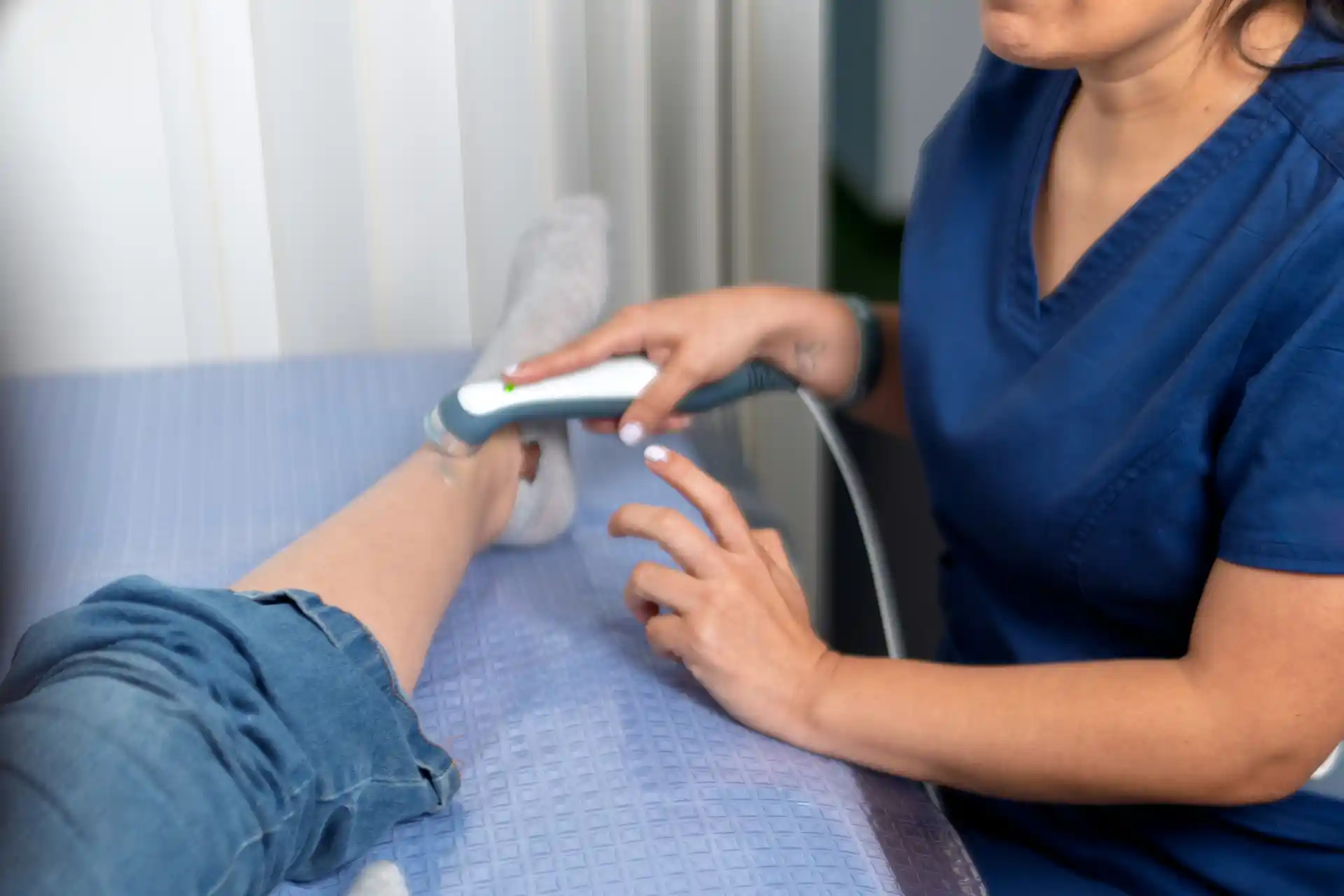If you have ever experienced a nagging muscle strain or struggled with lingering myalgia, you might have come across recommendations for ultrasound for muscle injury.
This approach can fit into a broader recovery plan and may be simpler than you expect.
Below, we will explore how ultrasound works, its benefits, and how you can decide if it aligns with your path to healing.
Understanding Ultrasound Therapy
Ultrasound therapy relies on high-frequency sound waves (above 20,000 Hz) to interact with your soft tissues. In a clinical setting, your therapist applies a special gel to your skin, then glides a handheld device over the area.
These sound waves penetrate below the surface, promoting blood flow and tissue repair.
What is Ultrasound Therapy
Ultrasound therapy is a noninvasive method that uses sound waves to help detect or treat common issues such as muscle spasms, tendinopathy, and soft tissue injury.
A 2022 review revealed that low-intensity therapeutic ultrasound (LITUS) boosted muscle healing and tendon function in as little as five days (PubMed Central). This may translate to milder pain and faster progress when dealing with something like a pulled muscle in back or a calf strain.
How It Works
Therapeutic ultrasound is thought to work through two main effects:
- Thermal Effects: Continuous ultrasound warms tissue, which can ease stiffness and improve flexibility. It may be especially helpful if you have chronic inflammation.
- Non-Thermal Effects: Pulsed ultrasound focuses on cellular-level changes, such as boosting protein synthesis and promoting cell metabolism (NCBI). This approach can increase collagen alignment and speed up your natural healing response.
Daily or near-daily therapy may help you recover faster from a muscle strain in neck or a more extensive injury like a hip flexor strain.
Read more on muscle injuries and chronic pain to support your knowledge on soft tissue injury recovery.
Key Benefits Of Ultrasound For Muscle Injuries
When used appropriately, ultrasound offers targeted benefits that could be a game-changer in your rehabilitation journey.
Let us look at the top reasons you might consider ultrasound for muscle injury.
How Ultrasound Aids Recovery
Muscle injuries usually involve tiny tears in the muscle fibers that need time and proper support to heal. Ultrasound therapy helps your body repair itself more efficiently through several key mechanisms:
- Boosts circulation and oxygen delivery:
The sound waves increase blood flow to injured tissue, bringing in more oxygen, nutrients, and white blood cells that fuel healing. This process also helps remove waste products that can slow recovery. Research even shows nearly double the satellite cell growth—the cells responsible for muscle repair—after low-intensity ultrasound (NCBI). - Supports tendons and ligaments:
If the injury extends into nearby connective tissues, ultrasound can help those heal too. Studies report that ligaments exposed to therapeutic ultrasound gain greater strength, stiffness, and flexibility, reducing the risk of re-injury. - Encourages proper collagen alignment:
Collagen acts as the body’s natural “scaffolding” for muscle repair. Ultrasound helps newly formed collagen fibers organize correctly, making the healing tissue stronger, more flexible, and less likely to scar or tear again.
Easing Pain and Inflammation
Pain and swelling often go hand-in-hand with muscle injuries. Ultrasound therapy helps manage both by improving circulation and stimulating natural anti-inflammatory responses. The result is less stiffness, easier movement, and a quicker return to activity.
- Heat therapy for chronic tightness:
In continuous mode, ultrasound gently warms deep tissue, relaxing tense muscles and improving flexibility. This can be especially helpful for chronic strain, overuse injuries, or persistent stiffness. - Pulsed mode for acute injuries:
For new injuries or inflamed areas, pulsed ultrasound delivers short bursts of sound energy without overheating tissue. This approach helps control inflammation while maintaining mobility during early recovery.
By reducing discomfort, ultrasound can make physical therapy and stretching more effective—and far less painful.
Improving Accuracy Through Real-Time Imaging
Many advanced clinics now use diagnostic ultrasound alongside therapeutic sessions to guide and personalize care. Real-time imaging allows clinicians to see exactly how muscles and soft tissues respond to treatment, leading to more precise and effective results.
- Pinpoints the exact injury:
Ultrasound can distinguish between a mild muscle strain and more serious damage, helping avoid misdiagnosis and unnecessary delays in care. - Guides treatments and injections:
If procedures such as injections are needed for conditions like tendinitis or bursitis, ultrasound imaging ensures precise needle placement for maximum safety and benefit. - Tracks your healing progress:
Follow-up scans allow your care team to visually confirm improvement, adjust your plan, and ensure that the tissue is healing as expected.
This combination of treatment and visualization makes ultrasound a valuable tool—not just for recovery, but for preventing setbacks.
Common Concerns And Safety
Ultrasound therapy has a low complication rate, but it is smart to explore potential risks and decide if it fits your recovery path.
Potential Risks And Side Effects
Although complications are rare, you will want to be aware of possible downsides:
- Superficial Burns: Prolonged exposure to continuous ultrasound might cause heat to build up too quickly (WebMD). Most therapists apply careful techniques to avoid that.
- Minor Discomfort: If you experience discomfort, mention it right away so the therapist can adjust the settings.
- Contraindications: Ultrasound therapy is not recommended near a pregnant woman’s womb, over a pacemaker, or over areas with active infection. High-intensity treatments can cause internal bleeding or scarring in extreme cases (WebMD).
Be sure to let your healthcare provider know about any implants, existing injuries, or health conditions before starting ultrasound sessions.
Is It Right For Everyone?
Ultrasound therapy can be highly effective for knee issues and various muscle strains, yet it might be less beneficial for some shoulder injuries.
In addition, you might not need ultrasound if your injuries respond better to other methods like targeted stretches, rest, or gentle massage.
Here are a few questions to guide your decision:
- Have you tried conservative measures such as rest, compression, and pain-relieving exercises first?
- Is your primary struggle a soft tissue injury, or do you need imaging to confirm a partial tear vs a full tear?
- Do you need specialized help for something like an intercostal muscle strain or a pulled chest muscle, where ultrasound might be less common?
Feel free to discuss these points with your physical therapist. Good news, you can often use ultrasound therapy in tandem with other rehab approaches, such as how to speed up muscle strain recovery or muscle recovery routines.
Next Steps For Your Recovery
Putting ultrasound therapy into your plan does not have to feel overwhelming. Here is a straightforward path you can follow.
- Talk With Your Physical Therapist
- A professional evaluation can determine whether ultrasound therapy is appropriate. This is especially important if you face complex injuries, like a hamstring injury combined with a pulled groin muscle.
- Combine Methods
- Ultrasound works best when paired with the right blend of rest, exercise, and manual therapy. You might learn gentle stretches that protect your tissues, or you could try joint-supporting exercises to reduce your risk of overtraining syndrome.
- Keep Track Of Progress
- If your clinic offers real-time ultrasound imaging, you can watch for improved muscle structure and reduced swelling. Otherwise, aim to log changes in range of motion, pain levels, and daily function.
- Evaluate Frequency And Intensity
- Based on your injury, your therapist may recommend continuous ultrasound for chronic issues or pulsed ultrasound for acute discomfort. The schedule might change as you heal, so stay in close touch with your care team about how you feel.
- Practice Daily Self-Care
- Support your therapy sessions with home exercises, hydration, and healthy nutrition. This might include gentle movements (like hip flexor stretches or short walks) that promote circulation. Also, remember to address broader concerns, such as a soft tissue injury or persistent muscle adhesions, which can slow down your body’s natural repair.
By understanding how ultrasound works, acknowledging its limitations, and pairing it with high-quality care, you are setting yourself up for a healthier, stronger future.
Remember, consultation with a healthcare professional is key, so do not hesitate to bring up ultrasound therapy during your next visit.
Seek RELIEF®
RELIEF® is an evidence-backed treatment that targets dysfunctional fascia—the connective tissue that surrounds and supports muscles. When fascia becomes tight or adhered after injury, it can restrict movement, cause pain, and slow recovery.1,2
Using a minimally invasive hydrodissection technique, RELIEF® gently separates and releases adhered fascia and may help restore healthy tissue mobility and improve muscle recovery—without the need for steroids, surgery, anesthesia, or extended downtime.3,4,5
If you’re in the Miami area and recovering from a muscle injury, contact us today to schedule a consultation and learn how RELIEF® can help restore your mobility and comfort.

.webp)




.svg)